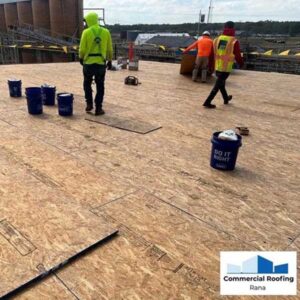
Roof replacement is an important aspect of commercial building maintenance that should not be overlooked. Neglecting the signs of a deteriorating roof can lead to costly damages and significant disruptions to your business operations. In this article, we will discuss the need for commercial roof replacement, how to choose the right roofing material, the roof replacement process, cost and time considerations, and the importance of hiring a professional roofing contractor.
Understanding the Need for Roof Replacement
As a commercial building owner, it is crucial to be aware of the signs indicating that your roof needs replacement. Ignoring these signs can result in more severe issues such as leaks, structural damage, and compromised insulation. Here are some common signs that your commercial roof may need replacement:
Signs Your Commercial Roof Needs Replacement
1. Age: Most commercial roofs have a lifespan of 20-30 years. If your roof is approaching or has exceeded its expected lifespan, it is time to consider replacement.
2. Visible damage: Look for signs of cracked, warped, or missing shingles, as well as general wear and tear.
3. Leaks and moisture problems: Water stains on the ceiling or walls, mold growth, and wet insulation are all indications of a failing roof.
4. Energy inefficiency: If you notice a significant increase in your energy bills, it could be due to a poorly insulated or damaged roof.
The Impact of Neglecting Roof Replacement
Choosing to ignore the need for commercial roof replacement can have severe consequences for your business. Neglecting roof maintenance can lead to:
- Interior damage to ceilings, walls, and valuable equipment.
- Increased energy costs due to inadequate insulation.
- Health hazards such as mold growth and poor indoor air quality.
- Disruptions to your business operations during emergency repairs.
Furthermore, delaying roof replacement can also affect the overall structural integrity of your commercial building. A compromised roof can lead to water infiltration, which can weaken the building’s foundation over time. This can result in costly repairs and potentially unsafe working conditions for your employees.
Regular roof inspections by qualified professionals can help identify issues early on and prevent extensive damage. Investing in routine maintenance and timely roof replacements can save you money in the long run by avoiding major repairs and preserving the value of your property.
Choosing the Right Roofing Material
When it comes to selecting the roofing material for your commercial building, there are several factors to consider. Each type of roofing material has its advantages and disadvantages, so it is crucial to make an informed decision based on your building’s needs and your long-term goals.
Comparing Different Roofing Materials
1. Metal Roofing: Metal roofs are known for their durability and longevity. They offer excellent resistance against fire, wind, and impact. Additionally, metal roofs are energy-efficient and environmentally friendly.
2. TPO Roofing: TPO (Thermoplastic Olefin) roofing is a popular choice due to its cost-effectiveness and energy efficiency. TPO roofs provide excellent resistance against UV rays, chemicals, and punctures.
3. EPDM Roofing: EPDM (Ethylene Propylene Diene Monomer) roofs are highly durable and have a low maintenance requirement. They offer excellent resistance to UV rays and extreme temperatures.
4. Built-Up Roofing (BUR): BUR roofs consist of multiple layers of asphalt and ply sheets. They are known for their durability and ability to withstand harsh weather conditions.
Factors to Consider When Choosing Roofing Material
1. Climate: Consider the climate of your location and choose a roofing material that can withstand the elements. For example, if you live in an area with extreme weather conditions such as heavy rainfall or strong winds, a metal roof or a BUR roof might be the best choice. These materials have proven to be highly resistant to such conditions, providing your building with the necessary protection.
2. Budget: Determine your budget and explore roofing options that offer a good return on investment. While metal roofing may have a higher upfront cost, its long lifespan and energy efficiency can result in significant savings in the long run. On the other hand, TPO roofing is a more cost-effective option that still provides excellent performance and durability.
3. Maintenance requirements: Evaluate the maintenance needs of different roofing materials and choose one that aligns with your maintenance capabilities. EPDM roofing, for instance, requires minimal maintenance and is resistant to UV rays, making it an ideal choice for buildings where regular upkeep might be a challenge.
Additionally, when considering maintenance, it is essential to think about the lifespan of the roofing material. Metal roofs, for example, can last up to 50 years or more with proper maintenance, while TPO roofs typically have a lifespan of around 20-30 years.
By carefully considering these factors and understanding the unique characteristics of each roofing material, you can make an informed decision that will ensure the long-term protection and performance of your commercial building.
The Roof Replacement Process
Once you have determined that roof replacement is necessary, it is essential to understand the steps involved in the process.
Initial Roof Inspection and Assessment
A professional roofing contractor will conduct a thorough inspection of your existing roof. They will assess the overall condition and identify any underlying issues that need to be addressed.
Preparing for Roof Replacement
Prior to the actual replacement, preparations need to be made to minimize disruptions to your business. This may involve temporarily relocating equipment and ensuring proper safety measures are in place.
The Actual Roof Replacement Process
The roof replacement process typically involves the removal of the existing roof, followed by the installation of the new roofing material. A professional roofing contractor will ensure that all necessary steps are taken to guarantee a high-quality and long-lasting roof.
Cost and Time Considerations
Estimating the cost of roof replacement depends on various factors such as the size of the roof, choice of roofing material, and complexity of the project.
Estimating the Cost of Roof Replacement
It is recommended to obtain multiple quotes from reputable roofing contractors to compare costs. While it may be tempting to choose the cheapest option, prioritize quality and expertise when making your decision.
Understanding the Time Frame for Roof Replacement
The duration of roof replacement can vary depending on factors such as the size of the roof, weather conditions, and the complexity of the project. It is important to discuss the timeline with your chosen roofing contractor and plan accordingly to minimize disruptions to your business operations.
Hiring a Professional Roofing Contractor
When it comes to commercial roof replacement, it is crucial to hire a professional roofing contractor with experience in commercial projects. A professional contractor will ensure the highest quality workmanship and provide you with peace of mind throughout the process.
Why You Should Hire a Professional
1. Expertise: Professional roofing contractors have the knowledge and skills to assess, recommend, and efficiently complete commercial roof replacement projects.
2. Safety: Roof replacement involves working at heights and handling heavy materials. Professionals adhere to strict safety regulations to protect both their workers and your property.
3. Warranty and Insurance: Reputable roofing contractors provide warranties on their workmanship and are adequately insured, giving you added protection and peace of mind.
What to Look for in a Roofing Contractor
1. Experience: Choose a contractor with a proven track record in commercial roof replacement.
2. Licenses and Certifications: Verify that the contractor holds the necessary licenses and certifications required by local authorities.
3. References: Ask for references and take the time to check their previous work to ensure quality results.
In conclusion, commercial roof replacement is a crucial aspect of building maintenance. By understanding the signs that indicate the need for replacement, choosing the right roofing material, following the appropriate process, considering cost and time factors, and hiring a professional roofing contractor, you can ensure a durable and long-lasting roof for your commercial property. Don’t overlook the importance of proper roof maintenance and take the necessary steps to protect your investment.
Ready to ensure your commercial property is safeguarded with a top-quality roofing system? Look no further than Commercial Roofing Rana, where our commitment to excellence has protected businesses across the Mid-South since 1983. From industrial complexes to shopping centers, our licensed professionals utilize the unparalleled Duro-Last roofing systems to deliver a perfect fit and superior protection for your building. Don’t wait for the next rainstorm to test your defenses. Schedule Now with Commercial Roofing Rana and secure your investment with our reliable and expert roofing services.
